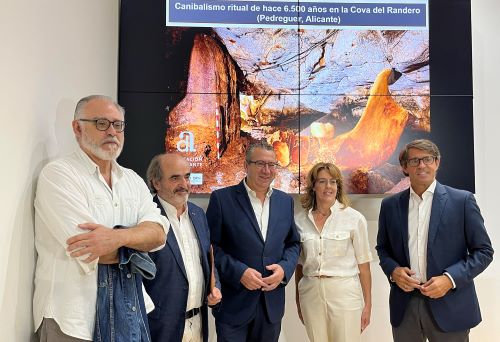
The excavations carried out in the Cova del Randero of Pedreguer have confirmed the first finding of ritual cannibalism in the Levante Peninsular in the Neolithic context. This was announced this morning by the president of the Diputación de Alicante, Toni Pérezafter presenting the conclusions of the research work carried out in the framework of the MARQ's Archaeological Excavations and Research Plan.
MARQ archaeologists and taphonomy specialists of the Institut Valencià de Conservació, Restauració i Investigació (IVCR+i) have unveiled this discovery, which dates back to pastoralist, farming and artisan communities 6,400 years ago. As stated by Toni Pérez, who was accompanied by the deputy for Culture, Juan de Dios Navarroand the mayor of Pedreguer, Sergi FerrúsThe Provincial Council remains firmly committed to research through the MARQ's annual excavation plan and, in this case, we have had the opportunity to create alliances to go hand in hand with the Pedreguer Town Council for years of work and highlight the rich historical and cultural heritage of the Cova del Randero".
An interdisciplinary team in archaeology, anthropology and archaeozoology led by Jorge A. Solerprehistorian and director of MUBAGConsuelo Roca de Togoresarchaeologist of the Diputación, Mª Pilar Iborra y Rafael Martínez ValleThe conclusions of this work have been made public by the IVCR+i, the IVCR+i based on the determination of signs of disarticulation, fleshing or human tooth marks on human bones. The results were also presented last September at two international scientific forums: the VIII International Congress on the Neolithic in the Iberian Peninsula of the University of Alcalá de Henares and the XVII National and International Congress of Palaeopathology of the Museum of Segovia.
Soler explained that the cannibalism was a relatively common activity during the Neolithic period.In the Iberian Peninsula, it is mainly concentrated in areas of Andalusia. The causes, according to different authors, could be gastronomic, due to violence or ritual. "In Randero, the lack of signs of violence in any of the bones preserved, added to the fact that those with marks correspond to children, suggests that they were eaten as a selective ritual act linked to funeral mourning, in a family context, consumed in what could be part of a funeral ritual, in a circular thought where death is projected onto life, making the memory of a living and loved one one one's own", pointed out Roca de Togores.
6,400 years ago, a group of the shepherd community that frequented or resided in the Cova del Randero for domestic livestock and their meat processing, threw into a internal gallery used as a rubbish dumpThe domestic waste, which included a large quantity of processed animal bones (mainly sheep and goats), together with bone fragments belonging to a minimum of eight human skeletons, including adults and children. Two bones, a fragment of mandible from a child of about six years of age and an ulna from a perinatal at about 40 weeks of gestation, which show clear evidence of peri-mortem anthropic manipulationi.e. when the bone was still fresh, which confirm a selective cannibalism.
In 2023, the research has identified several types of anthropic markingsThe following are some of the most common examples: cuts made with stone tools for disarticulation and fleshing, bending fractures to gain access to the marrow and human bites, in some cases resulting in the destruction of parts of the bone.
Work at this site has been carried out throughout the year. fourteen campaigns (2007 - 2021) of MARQ's Excavation Planwith the support of the Pedreguer Town CouncilAlthough the findings took place in 2018 and laboratory research is still ongoing at present. Until now, the importance of the cave lies in the fact that it has been excavated at Middle Neolithic levels, offering a wealth of data on the management and organisation of the physical and temporal space.
In addition, Jorge Soler added that other human bones with human bites and cut marks from the Marina Alta region were also published in 2017. Cova de Santa Maira in Castell de Castells, which date back to the Mesolithic period. -hunters and gatherers-, "all of which contributes to making the province of Alicante a point of reference in the framework of prehistoric and paleoanthropological research".
